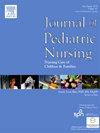新生儿重症监护室使用海绵浴和襁褓浴对新生儿舒适度的影响:一项随机对照试验
IF 2.1
4区 医学
Q2 NURSING
Journal of Pediatric Nursing-Nursing Care of Children & Families
Pub Date : 2025-07-09
DOI:10.1016/j.pedn.2025.06.048
引用次数: 0
摘要
目的沐浴是新生儿护理的重要组成部分,可能影响生理稳定性、应激水平和整体舒适度。本研究旨在比较海绵浴和襁褓浴对新生儿舒适度和生理反应的影响。设计与方法于2024年3月至9月在土耳其伊兹密尔一家三级医院的新生儿重症监护病房(NICU)进行了一项随机对照试验。本研究共纳入71例生理稳定、无沐浴禁忌症的足月新生儿,采用分组随机法随机分为襁褓沐浴组(n = 35)和海绵沐浴组(n = 36)。在洗澡前、洗澡后10分钟和洗澡后1小时三个时间点,使用comfort Neo量表评估新生儿的生理参数(脉搏率、血氧饱和度和体温)和舒适度。数据分析采用独立样本t检验、卡方检验和事后功率分析SPSS版本26。结果沐浴后10 min,襁褓浴组平均脉搏率显著低于对照组(140.91±9.99 vs 148.52±14.66;p & lt;0.05),血氧饱和度高于海绵浴组(p = 0.001)。洗澡前和洗澡后10分钟的舒适评分在两组之间相似,不安(p <;0.001),疼痛评分(p = 0.004)明显低于襁褓浴组。结论在支持新生儿生理稳定性和提高新生儿舒适度方面,襁褓浴法比海绵浴法更有效。实践意义将襁褓浴法纳入新生儿重症监护病房的护理方案可以提高新生儿护理的质量和舒适度。本文章由计算机程序翻译,如有差异,请以英文原文为准。
Effects of sponge bath and swaddle bath applied in the neonatal intensive care unit on neonatal comfort: A randomized controlled trial
Purpose
Bathing is an essential part of newborn care and may influence physiological stability, stress levels, and overall comfort. This study aimed to compare the effects of sponge bathing and swaddle bathing on newborn comfort and physiological responses.
Design and methods
A randomized controlled trial was conducted in the Neonatal Intensive Care Unit (NICU) of a tertiary hospital in Izmir, Turkey, between March and September 2024. A total of 71 term, physiologically stable newborns without contraindications for bathing were enrolled and randomly assigned to either the swaddle bath group (n = 35) or the sponge bath group (n = 36) using block randomization. Physiological parameters (pulse rate, oxygen saturation, and body temperature) and newborn comfort levels were assessed using the COMFORT Neo Scale at three time points: before the bath, 10 min after, and 1 h after bathing. Data were analyzed using independent samples t-tests, chi-square tests, and post hoc power analysis in SPSS version 26.
Results
Ten minutes after bathing, the swaddle bath group showed significantly lower mean pulse rates (140.91 ± 9.99 vs. 148.52 ± 14.66; p < 0.05) and higher oxygen saturation (p = 0.001) compared to the sponge bath group. While pre-bath and 10-min post-bath comfort scores were similar between groups, restlessness (p < 0.001) and pain scores (p = 0.004) were significantly lower in the swaddle bath group.
Conclusion
The swaddle bath technique is more effective than the sponge bath method in supporting physiological stability and enhancing newborn comfort.
Practice implications
Incorporating the swaddle bath method into NICU care protocols may improve the quality and comfort of neonatal care practices.
求助全文
通过发布文献求助,成功后即可免费获取论文全文。
去求助
来源期刊

Journal of Pediatric Nursing-Nursing Care of Children & Families
NURSING-PEDIATRICS
CiteScore
3.70
自引率
8.30%
发文量
291
审稿时长
65 days
期刊介绍:
Official Journal of the Society of Pediatric Nurses and the Pediatric Endocrinology Nursing Society (PENS)
The Journal of Pediatric Nursing: Nursing Care of Children and Families (JPN) is interested in publishing evidence-based practice, quality improvement, theory, and research papers on a variety of topics from US and international authors. JPN is the official journal of the Society of Pediatric Nurses and the Pediatric Endocrinology Nursing Society. Cecily L. Betz, PhD, RN, FAAN is the Founder and Editor in Chief.
Journal content covers the life span from birth to adolescence. Submissions should be pertinent to the nursing care needs of healthy and ill infants, children, and adolescents, addressing their biopsychosocial needs. JPN also features the following regular columns for which authors may submit brief papers: Hot Topics and Technology.
 求助内容:
求助内容: 应助结果提醒方式:
应助结果提醒方式:


